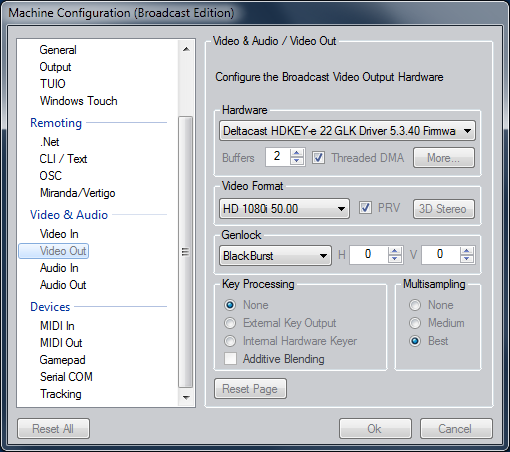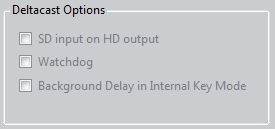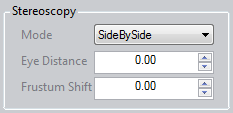Broadcast Video Output
Table of Contents
The Broadcast Video Output settings are only available in the Ventuz Broadcast Edition. They configure the video format of input and output signals as well as key processing and rendering quality. Additional hardware specific settings are also available.

Hardware
Video Board
Ventuz currently support 4 different types of SDI video boards. All boards have their pros and cons - especially in pricing and quality. All Vendors provide differently featured versions of their products. Please contact your Ventuz Integrator for details.
| Vendor | Boards | Inputs | Outputs | Remarks |
|---|---|---|---|---|
| Deltacast | Delta-sdi Delta-hd | 2 | 1 Fill+Key | |
| DVS | Centaurus II | 2 | 1 Fill+Key | |
| Blackmagic | Decklink Series | - | 1 Fill+Key | Decklink boards can only operate as an output or input board. Not as both simultaneously! |
| Matrox | X.mio | 2 | 1 Fill+Key | This board is used for Miranda X-3D and X-Ventuz only. |
Video inputs provided by the selected video hardware are always inserted before the system enumerated device list referenced by the Video In page of the Machine Configuration.
Deltacast
The Deltacast sd and hd sdi boards have been designed for real-time video IO in television broadcast. They provide precisely the feature set required for reliable SDI IO and VANC processing. Neither more, nor less. The Deltacast product range is the official Ventuz recommendation. Please contact Ventuz sales or your Ventuz Broadcast Integrator for details.
Additional options for Deltacast boards:

- SD input on HD output
Enabling this option allows to feed SD inputs even if the output is configured in HD where the timing has to be equal for input and output. - Watchdog
Enabling this option activates the hardware watchdog provided by the Delta-hd-key boards. The watchdog gets armed on every frame transferred to the video board. If Ventuz fails to transfer the next frame within the configured amount of time the watchdog will enter a failsafe mode: the two bypass relays will pass through input1 to output1 and input2 to output2
A power-fail will always close the bypass-circuit independently of the watchdog settings. - Background delay in internal key mode
The special operation mode turns a Ventuz/Deltacast machine into a full high quality 3D DVE with power fail and delay capabilities. If enabled, the internal keyer uses Input2 as a background signal, with the video still available in Ventuz as a Live Video Texture. The background gets delayed on a hardware basis to exactly match the 3D processing delay of Ventuz (4 frames). This allows seamless transitions from the hardware processed background to the software processed (Ventuz) image.
Blackmagic
Blackmagic Design provides several (cheap) solutions for SDI output (Fill+Key). The boards have been designed for connecting a tape deck to a PC for recording and playback to tape. Therefore, the product name is Decklink and the boards can either output or input SDI signals - but not both.
Some of the Decklink boards have an internal keyer hardware onboard which make them a cost effective solution for downstream applications. Please note that Decklink boards do not provide any watchdog or power-fail options!
Additional options for Blackmagic boards:

If the used board provides an analog (monitoring) output these options allows to configure it.
DVS
The DVS Centaurus II board has been designed for very reliable and stable video IO between the SDI and PC worlds. It provides post-production formats such as 1080p@60 or 2k. In television broadcast these formats are usually not used and thus are not supported by Ventuz. The board comes with an optional keyer and is a reliable selection for both up-stream and down-stream applications.
Matrox
The Matrox x.mio board has been designed as a video toaster and for professional SDI IO for PC's. Miranda Technologies uses this board for their Ventuz based products X-3D and X-Ventuz. For internal key mode, the x.mio Compositor option must be enabled!
Buffers
This value defines the number of frame buffers used to output the graphics to SDI. The lowest value depends on the SDI hardware used. Usually this lowest value should be used. Higher values increase the general output delay, but also decrease the risk of frame drops. Crawl or roll application, for example, often use a higher number of buffers because the output delay is not an issue. Higher values also increase the video input to video output delay, therefore applications needing a short input-to-output-delay should keep this value as low as possible.
Threaded DMA
Some boards provide this option to enable a different mode of data transfer between video board and GPU. Depending on the type and content of the graphics the Threaded DMA may improve rendering performance. Trying both modes is recommended if the graphics load is approaching the limits of the real-time capabilities of the machine.
More
Some video boards have additional options. Press the More button to configure.
Video Format
Ventuz supports a list of standard video formats used in the professional TV broadcast market. Even if some boards support many more SDI standards, Ventuz does not support them as long as they are not used in TV broadcast. Additionally, some formats are not supported by certain video boards.
As soon as a video board has been selected, this list will only show formats supported by the selected hardware.
| Name | Rate | Frame Mode | Frame Size | Pixel Aspect |
|---|---|---|---|---|
| SD PAL | ||||
| SD PAL | 50.00 | interlaced | 720x576 | 16/15 |
| SD PAL 16:9 | 50.00 | interlaced | 720x576 | 64/45 |
| SD NTSC | ||||
| SD NTSC | 59.94 | interlaced | 720x486 | 9/10 |
| SD NTSC 16:9 | 59.94 | interlaced | 720x486 | 6/5 |
| HD 720p | ||||
| HD 720p | 50.00 | progressive | 1280x720 | 1/1 |
| HD 720p | 59.94 | progressive | 1280x720 | 1/1 |
| HD 720p | 60.00 | progressive | 1280x720 | 1/1 |
| HD 1080i | ||||
| HD 1080i | 50.00 | interlaced | 1920x1080 | 1/1 |
| HD 1080i | 59.94 | interlaced | 1920x1080 | 1/1 |
| HD 1080i | 60.00 | interlaced | 1920x1080 | 1/1 |
| HD 1080p | ||||
| HD 1080p | 25.00 | progressive | 1920x1080 | 1/1 |
| HD 1080p | 29.97 | progressive | 1920x1080 | 1/1 |
| HD 1080p | 30.00 | progressive | 1920x1080 | 1/1 |
Preview
Enabling the Preview will render the actual video output to a window on screen. This window is necessary to send interactive commands such as mouse and Windows MultiTouch events to the renderer. If the Preview is disabled, only keyboard inputs will be accepted.
The Preview is not a preview in the sense of previewing the next graphical element that is going to appear on-air. It is only an additional output of the signal sent to the SDI board.
The Preview window is not synchronized to the actual SDI board. The SDI board has its own timing hardware. The graphics here are not synchronized to the SDI board. Animation or videos may stutter, because they are synchronized to the SDI output - not to the graphics board (and thus the preview window). Also tearing effects may appear.
Interlaced video formats are displayed progressive: a 1080@25i format will be display as it would be a 1080@50p format, because Ventuz always renders progressive frames internally.
3D Stereo
Ventuz supports 3D stereoscopic graphics. In order to render a stereo view of a 3D scene, the scene needs to be rendered twice: left and right eye view. The parameters for the two eyes are called Eye Distance and Frustum Shift. Ventuz does not make any correlation of the internal coordinate system to any real-world units, therefore there are no default or recommended values for these two parameters. The Eye Distance is understood as the distance between the two eyes (or lenses) looking into the 3D world. The Frustum Shift is a correction value to line up the two 3D perspective frustums again. The two values can be manually adjusted in the Broadcast Live Config which is accessible in the Render Window of Ventuz Designer and Ventuz Runtime.

- Disabled
No stereoscopy view. (Monoscopy) - Side-By-Side
This mode is a single-link squeeze mode where the left and right eye views are squeezed horizontally and placed side-by-side to fit one single video signal. This mode is currently the most common mode used in television broadcast because it uses the same transmission bandwidth and does not require any additional transmission devices. This mode is usually used in down-stream applications. - Top-Bottom
The top-bottom mode is the same as the side-by-side mode but the two outputs are stacked on top of each other. The vertical squeeze reduces the quality of the actual video images, especially in interlaced video modes. Therefore this mode is very rarely used in television broadcast. This mode is usually used in down-stream applications. - Dual Channel
The dual-channel mode requires two separate SDI outputs and is usually used in up-stream applications (graphics are inserted before multiplexing the two eye views for broadcasting).
The dual-channel mode is currently only supported on Deltacast boards.
Two boards are required in external or internal key mode!
Genlock
The genlock configuration defines which source is used to synchronize the video output. The availability of genlock source depends on the used hardware and its feature set. Some genlock sources allow for a constant delay to adjust the phase of the outgoing signals. The two values H and V define that delay in pixels (clocks) and lines. Some boards also provide the ability of a negative delay, but usually these values are positive.
Key Processing
- No Key
This option does not output or process any key signal at all and is used for full-screen graphics. - External Key
This option outputs a second signal with keying information where black pixels mean 100% transparent and white pixels mean 100% opaque graphics. Of course, the video hardware must be able to support this mode! Some boards requires a keying hardware or software option.
The external key is used in up-stream applications. - Internal Key
The internal keyer requires video boards with special hardware or software options in order to be selectable. In internal key mode, Ventuz produces graphics plus opacity information (key) and blends the graphics over a background video. The advantage of using a hardware based keyer is that the signal quality of the outgoing signal is maintained and ensured by the video board and not by Ventuz, Windows or just a PC.
This option is used in down-stream applications. - Additive Blending
This option changes the default Blend Function used to blend pixels during the rasterization of the graphical elements. It also changes the blending mode of the internal keyer from multiplicative to additive blending. Other software call this mode Pre-multiplied Alpha.
Multisampling
Select the quality of multisampling used to render a scene.
Multisampling only affects the edges of geometries. It does not affect the quality of textures, texture based text or live video textures!
- None
No multisampling applies. - Medium
Selects the mid range (Best/2) of available multisampling quality levels. - Best (default)
Selects the highest available level of multisampling quality.
Select None multisampling for scenes consisting of texture and texture based fonts only or if the displayed graphics is a 2D design. Multisampling would not improve the quality but it will lower the rendering performance!